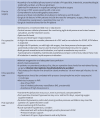Management of pulmonary hypertension in special conditions
- PMID: 39209477
- PMCID: PMC11525332
- DOI: 10.1183/13993003.01180-2024
Management of pulmonary hypertension in special conditions
Abstract
Care of pulmonary hypertension (PH) patients in special situations requires insightful knowledge of the pathophysiology of the cardiopulmonary system and close interaction with different specialists, depending on the situation. The role of this task force was to gather knowledge about five conditions that PH patients may be faced with. These conditions are 1) perioperative care; 2) management of pregnancy; 3) medication adherence; 4) palliative care; and 5) the influence of climate on PH. Many of these aspects have not been covered by previous World Symposia on Pulmonary Hypertension. All of the above conditions are highly affected by psychological, geographical and socioeconomic factors, and share the need for adequate healthcare provision. The task force identified significant gaps in information and research in these areas. The current recommendations are based on detailed literature search and expert opinion. The task force calls for further studies and research to better understand and address the special circumstances that PH patients may encounter.
Copyright ©The authors 2024.
Conflict of interest statement
Conflict of interest: I.R. Preston reports grants from Janssen, Merck, United Therapeutics and Respira, consultancy fees from Janssen, Merck, United Therapeutics, Liquidia, Gossamer and Aerovate, payment or honoraria for lectures, presentations, manuscript writing or educational events from Janssen and United Therapeutics, and support for attending meetings from Janssen and United Therapeutics. L.S. Howard reports grants from MSD, consultancy fees from Ferrer, Janssen and Morphic, payment or honoraria for lectures, presentations, manuscript writing or educational events from Janssen, MSD, Aerovate and Ferrer, payment for expert testimony from Janssen, support for attending meetings from Janssen and Gossamer Bio, participation on a data safety monitoring board or advisory board with MSD, Janssen, Gossamer Bio, Apollo Therapeutics and Altavant, and stock (or stock options) with Circular, ATXA Therapeutics, iOWNA, Calibre Biometrics and OneWelbeck Clinic. D. Langleben reports grants from Acceleron/Merck, Aerovate and Janssen, consultancy fees from Merck, Janssen, Actelion, Enzyvant, PhaseBio, Gossamer Bio and Bayer, payment or honoraria for lectures, presentations, manuscript writing or educational events from Merck, Janssen and Bayer, support for attending meetings from Acceleron/Merck, Janssen, Enzyvant and Gossamer Bio, and participation on a data safety monitoring board or advisory board with Phase Bio, Merck, Janssen, Actelion, Enzyvant and Gossamer Bio. M. Lichtblau reports payment or honoraria for lectures, presentations, manuscript writing or educational events from, and participation on a data safety monitoring board or advisory board with MSD, and support for attending meetings from MSD and Janssen. T. Pulido reports grants from Aerovate, Bayer, Janssen, MSD, Pfizer and United Therapeutics, consultancy fees from Bayer, MSD, Gossamer Bio, Aerovate and Ferrer, payment or honoraria for lectures, presentations, manuscript writing or educational events from Bayer, Janssen, MSN Labs, Tuteur and Ferrer, support for attending meetings from Bayer, Janssen and Ferrer, participation on a data safety monitoring board or advisory board with Janssen, MSD, Bayer and Gossamer Bio, and is consultant and part of the advisory board for the Mexican Society of Pulmonary Arterial Hypertension. R. Souza reports payment or honoraria for lectures, presentations, manuscript writing or educational events from Bayer and Janssen, and participation on a data safety monitoring board or advisory board with Janssen, Bayer and MSD. K.M. Olsson reports grants from Acceleron, MSD and Janssen, consultancy fees from Acceleron, Actelion, Janssen, Ferrer, Merck, AOP Health, Gossamer and Bayer, payment or honoraria for lectures, presentations, manuscript writing or educational events from Acceleron, Actelion, AOP Health, Janssen, Bayer, MSD, Ferrer and Gossamer, and support for attending meetings from Acceleron/MSD and Janssen/Actelion.
Figures




Comment in
-
The Seventh World Symposium on Pulmonary Hypertension: our journey to Barcelona.Eur Respir J. 2024 Oct 31;64(4):2401222. doi: 10.1183/13993003.01222-2024. Print 2024 Oct. Eur Respir J. 2024. PMID: 39209470 Free PMC article.
References
Publication types
MeSH terms
LinkOut - more resources
Full Text Sources
Medical
